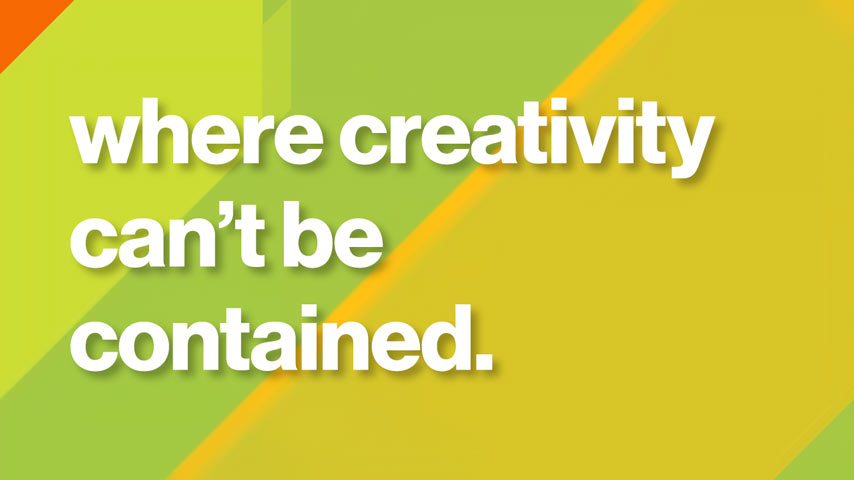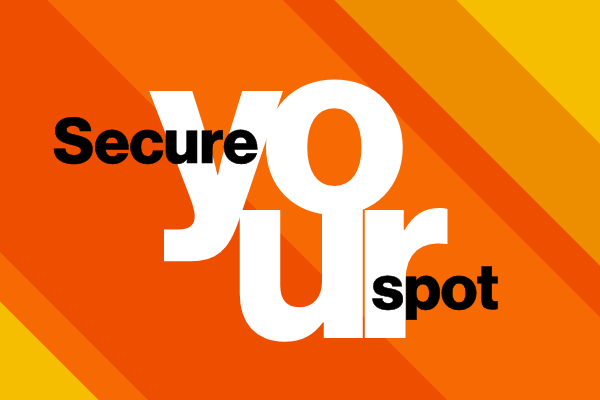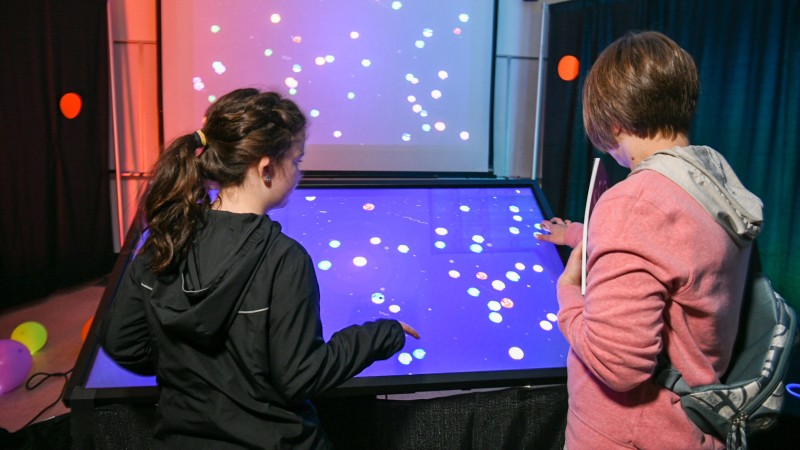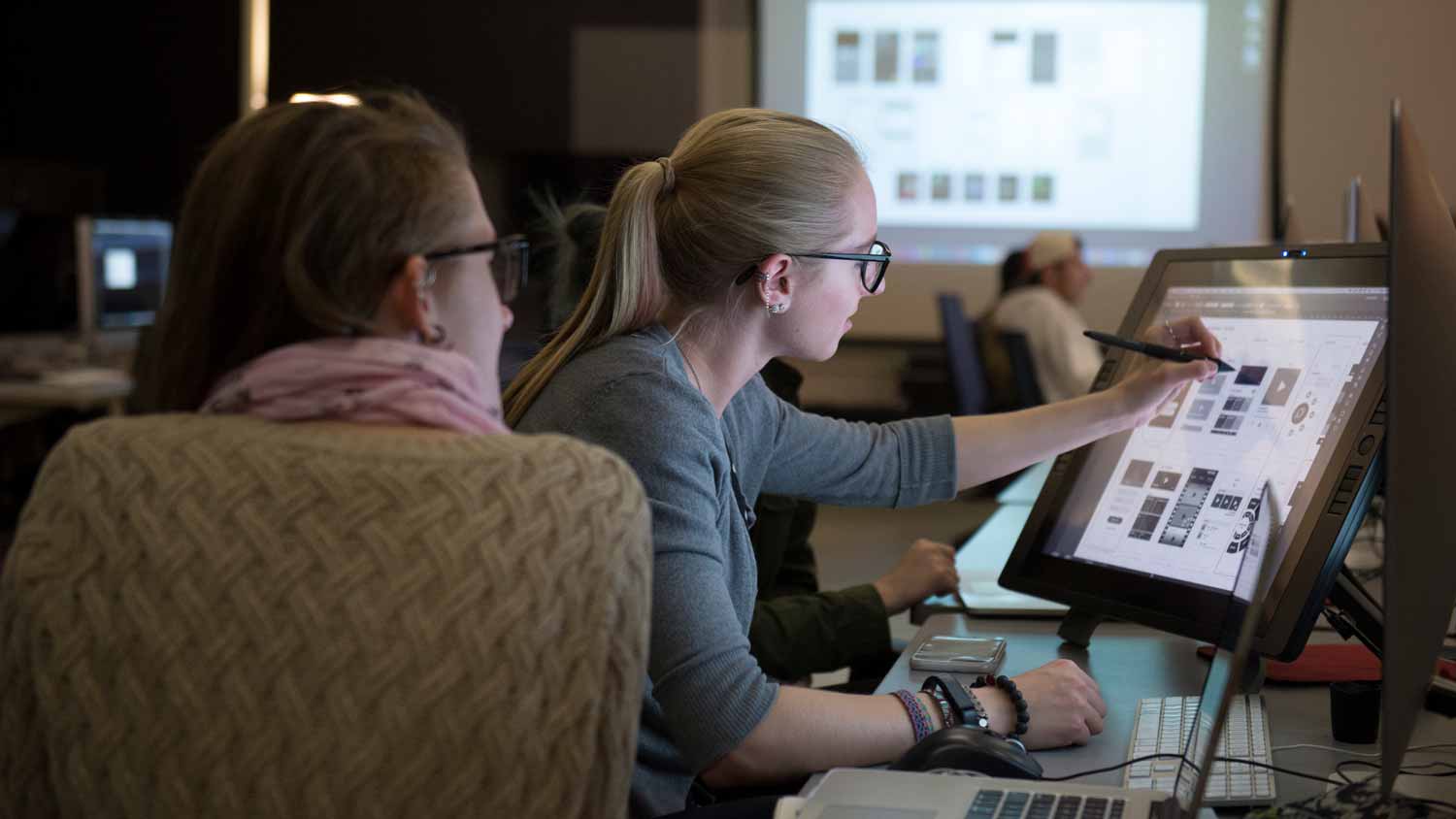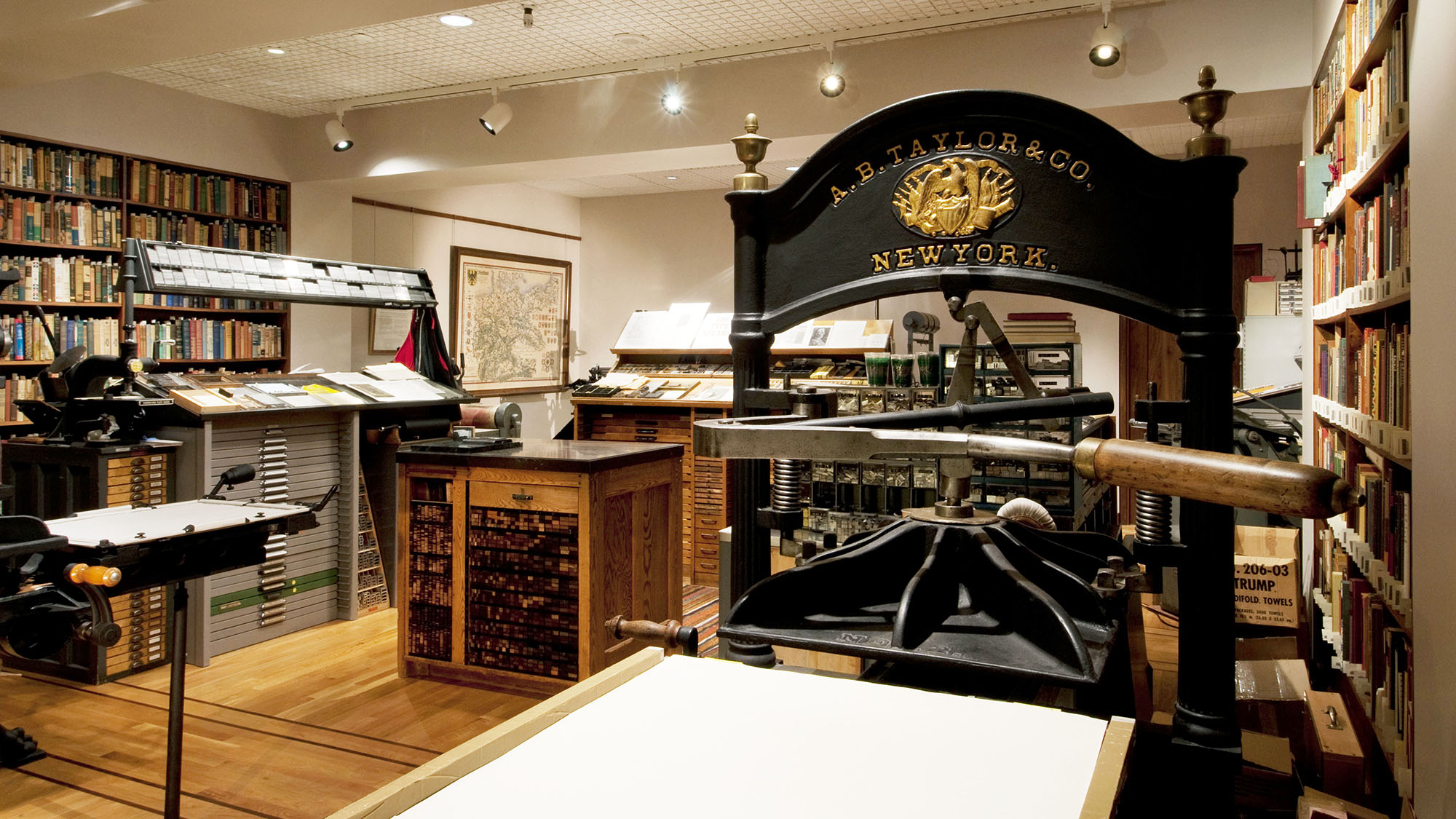New Media Design Bachelor of Fine Arts Degree

New Media Design
Bachelor of Fine Arts Degree
- RIT /
- Rochester Institute of Technology /
- Academics /
- New Media Design BFA
Overview for New Media Design BFA
Why Pursue a New Media Design Major at RIT?
An RIT New Economy Major: This collection of degree programs is forward-thinking and future-forming and helps prepare you to excel in the multidisciplinary nature of our modern, dynamic economy.
World-Class Facilities: Develop projects at RIT's MAGIC Spell Studios, a state-of-the-art facility featuring a fully functional film sound stage, sound mix, and color correction post-production studios, a 4K Dolby Atmos theater, and multiple media laboratories.
Gain Valuable Skills: Design cutting-edge interactive solutions–from mobile apps to fully immersive digital environments.
Real-world Experience: Address digital challenges for clients with the creation of AR and VR projections, games, and physical and mobile experiences. Past industry partners include Constellation Brands, Forbes, Rochester Regional Health, and the Rock & Roll Hall of Fame.
STEM-OPT Visa Eligible: The STEM Optional Practical Training (OPT) program allows full-time, on-campus international students on an F-1 student visa to stay and work in the U.S. for up to three years after graduation.
What is New Media Design?
Every day, millions of people engage in interactive digital experiences, from smartphones and smart TVs, to tablets, wearables, gaming systems, and more. In an interactive new media design degree, you’ll explore dynamic aspects of digital design–visual design, user experience design, interaction, motion graphics, and technology–that give you the skills you need to create captivating, interactive media.
What is New Media?
New media is an ever-changing form of digital communication that engages, immerses, and entertains its users.
The term new media was first coined in the mid-80s to refer to the impact computing was beginning to have on traditional forms of media, such as newspapers, radio, and television. But as digital platforms began to evolve beyond the internet, new media came to encompass all types of information and entertainment accessed by our computers, phones, and tablets. New media now encompasses anything that integrates communication, computing, and technology – from social media (Facebook, Instagram) and streaming services (Spotify, Hulu, Amazon Prime), to highly interactive digital technologies like wearables (Apple Watch, FitBit), virtual reality, augmented reality, and gaming.
RIT’s New Media Design Major
In the interactive design degree, you will build the skills you need to design for interactive media, including:
- Knowledge of visual design foundations
- 2D and 4D design
- animation
- Information design
- User interface design
- User experience design
- 3D modeling
- Motion graphics
- Web and multimedia technologies
- Usability research
- Programming.
You’ll design cutting-edge interactive solutions from mobile apps to fully immersive digital environments.
New Media Design Courses
Design for interactive media requires collaboration with programmers skilled in interactive design. As a student in the new media design major, you’ll benefit from close collaboration with students in RIT’s new media interactive development major, which focuses heavily on programming and interactive development. Courses in this major address the computing and programming side of new media design, with classes covering topics in:
- Mobile development and alternative interfaces
- Website design and implementation
- Physical/wearable computing
- Game design
- Game development
- Design and media production
- Interactive audio
- And more
Both programs share core courses in programming and design, enabling students in both majors to develop the complementary skill sets needed for success in the industry.
Your fourth year concludes with new media design capstone I and II, a two-course, two-semester capstone project in which you’ll team up with students from the new media interactive development major to work on a project for a corporate client looking for a solution to a digital challenge their organization faces. You’ll gain the teamwork experience needed as you learn to develop, navigate, and leverage the designer-programmer-client relationship. With many courses, both project- and team-based, you’ll build a robust portfolio of interactive projects, positioning you well to showcase your skills, capabilities, and knowledge to prospective employers upon graduation. View samples of new media team projects to see what our teams have created.
Connect with New Media Professionals
The School of Design maintains memberships in a variety of professional organizations that foster a community of design, new media, interactive design, and digital design professionals, including:
- Industrial Designers Society of America
- ACM Siggraph
- Society of Environmental Graphic Designers
- American Society of Interior Designers
- American Institute of Architects
- ICOGRADA
- American Institute of Graphic Arts
- International Interior Design Association.
Furthering Your Education in New Media Design
Today’s careers require advanced degrees grounded in real-world experience. RIT’s Combined Accelerated Bachelor’s/Master’s Degrees enable you to earn both a bachelor’s and a master’s degree in as little as five years of study, all while gaining the valuable hands-on experience that comes from co-ops, internships, research, study abroad, and more.
- +1 MBA: Students who enroll in a qualifying undergraduate degree have the opportunity to add an MBA to their bachelor’s degree after their first year of study, depending on their program. Learn how the +1 MBA can accelerate your learning and position you for success.
-
Next Steps to Enroll
Accept your offer of admission and take the next steps toward becoming an RIT Tiger.
Careers and Experiential Learning
Typical Job Titles
| App Designer | Creative Director | Design Director |
| Digital Product Designer | Graphic Designer | Interactive Designer |
| Junior Visual Designer | Motion Graphic Designer | Presentation Designer |
| Senior Visual Designer | UI/UX Designer | Web Developer |
Industries
-
Advertising, PR, and Marketing
-
Design
-
Electronic and Computer Hardware
-
Health Care
-
Higher Education
-
Insurance
-
Internet and Software
-
Journalism, Media, and Publishing
Careers in New Media Design
Digital media is everywhere, and we interact with it daily on phones, tablets, wearables, and in gaming. As a result, careers in digital media, new media design, and design for interactive media are booming. With an interactive media design degree, you will graduate with the skills and experience to launch a career in visualization design, interactive design, and user experience design for digital advertising, marketing, social media, mobile app development, web applications, entertainment, and gaming, and corporate design.
You’ll also be well-positioned to utilize your skills in video and audio production, game design, 4D design, television streaming and broadcasting, interactive website design, graphic design, illustration, and more.
Cooperative Education and Internships
What’s different about an RIT education? It’s the career experience you gain by completing cooperative education and internships with top companies in every single industry. You’ll earn more than a degree. You’ll gain real-world career experience that sets you apart. It’s exposure–early and often–to a variety of professional work environments, career paths, and industries.
Co-ops and internships take your knowledge and turn it into know-how. An art and design co-op provides hands-on experience that enables you to apply your artistic capabilities in dynamic professional settings while you make valuable connections between classwork and real-world applications.
Cooperative education, internships, and other experiential learning opportunities are encouraged for students in the BFA in new media design.
Creative Industry Days
Connect with Design Industry Leaders
RIT’s Office of Career Services and Cooperative Education hosts Creative Industry Days, which connects students majoring in art, design, film and animation, photography, and select computing majors with companies, organizations, creative agencies, design firms, and more. Creative Industry Days are a series of events that allow you to network with company representatives and interview directly for open co-op and full-time employment positions.
Featured Work and Profiles
-
New Media Design Portfolio Showcase
How can design do good? From games, apps and installations, students from the New Media Design program create exciting new experiences.
Read More about New Media Design Portfolio Showcase -
RIT to P&G: A Seamless Transition to Industry
Julia Tenney '24 RIT's new media design program had Julia Tenney looking like a seasoned veteran when she began working at Procter & Gamble as a UI designer right after graduating.
Read More about RIT to P&G: A Seamless Transition to Industry -
'Creative Collisions' Design and AI Workshop
Students from RIT's new media design (BFA) and visual communication design (MFA) programs collaborated on an annual multi-day design challenge called "Creative Collisions." For the workshop, teams...
Read More about 'Creative Collisions' Design and AI Workshop -
Student's Internship at Amazon Web Services Leads to Full-time Employment
Stephanie Liu was offered a full-time position as a user experience (UX) designer, working on the same team with which she interned.
Read More about Student's Internship at Amazon Web Services Leads to Full-time Employment -
Motion Design Competition
Digital and interactive experiences by new media design students that were recognized in MODE Fest, an international competition for student and emerging motion designers.
Read More about Motion Design Competition -
'Creative Collisons' Design Challenge 2023
Students from RIT's new media design (BFA) and visual communication design (MFA) programs teamed up for a three-day design challenge. Each team rapidly developed motion designs, animations,...
Read More about 'Creative Collisons' Design Challenge 2023
Curriculum for 2024-2025 for New Media Design BFA
Current Students: See Curriculum Requirements
New Media Design, BFA degree, typical course sequence
| Course | Sem. Cr. Hrs. | |
|---|---|---|
| First Year | ||
| NMDE-103 | New Media Design Interactive I |
3 |
This course provides an introduction to key internet, web and multimedia technologies. Topics covered include computer-based communication and information, basic HTML, Adobe Flash and WYSIWYG editors, basic internet applications such as FTP, basic use of digital images, audio and video techniques, web page design, web animation for development and publishing. (Prerequisites: NMDE-111 or equivalent course student standing in NMDE-BFA program.) Lab 3, Lecture 2 (Spring). | ||
| FDTN-111 | Drawing I |
3 |
This course is an introduction to the visualization of form, thought, and expression through the drawing process and is the first of two sequential courses that are the foundation of the drawing curriculum in the College of Art and Design. Concepts are introduced by lectures, discussions, and demonstrations which are designed to provide a broad introductory experience. Students will experiment with a wide variety of media, tools, techniques and subjects to develop drawing and problem-solving skills related to form and composition. The focus of the course is to provide awareness of the full range of ways in which drawing is used as a tool for both self-expression and communication. **Fee: A materials fee is required for this course, and an additional course fee applied via student account** Studio 6 (Fall or Spring). | ||
| Choose one of the following: | 3 |
|
| FDTN-112 | Drawing II |
|
From observation of still life, the figure, and interior/exterior spaces, Drawing II continues to build on the foundation of the College of Art and Design drawing curriculum. This course continues the study of traditional drawing mediums and techniques while introducing color and a selection of contemporary practices and tools through examining organic and geometric mark making, form, space and value. Core concepts are introduced by lectures, discussions, and demonstrations; the primary assessment method of course work will be through critiques which facilitate growth of both a visual and verbal vocabulary. The focus of the course is to provide awareness of the full range of ways in which drawing is used as a tool for self-expression, communication and continued development of creative practice and problem solving. **Fee: A materials fee is required for this course, and an additional course fee applied via student account** (Prerequisites: FDTN-111 or ITDI-211 or equivalent course.) Studio 6 (Fall or Spring). | ||
| FDTN-212 | Drawing II Workshop: Topics |
|
This course is an investigation of the visualization of form, thought and expression through the drawing process. This workshop provides students with the opportunity to learn more about a particular experience in drawing while still covering required foundation elements. Different topics may be taken in the same semester. Topics may only be taken once. Concepts are introduced by lectures, discussions, demonstrations, research and assigned projects.. The focus of the course is to provide awareness of the full range of ways in which drawing is used as a tool for both self-expression and communication. (Prerequisites: FDTN-111 or ITDI-211 or equivalent course.) Studio 6 (Spring). | ||
| FDTN-121 | 2D Design I |
3 |
This course is an introduction to the basic elements and principles of two-dimensional design and is foundational to the College of Art and Design curriculum. The focus of this course is the development of visual and verbal vocabularies as a means of exploring and understanding two-dimensional design. Students will engage with a wide variety of media, tools, and techniques to develop skills while delving into the theoretical and experimentational processes of contemporary art and design. The exploration of historical and cultural themes and concepts intertwined with aspects of personal interpretation and experience will be included in the curriculum. **Fee: A materials fee is required for this course, and an additional course fee applied via student account** Studio 6 (Fall or Spring). | ||
| FDTN-141 | 4D Design |
3 |
4D Design introduces students to the basic concepts of art and design in time and space. The course explores elements of moving images such as continuity, still and moving image editing, transitions and syntax, sound and image relations, and principles of movement. Computers, video, photo, sound and lighting equipment are used to create short-form time-based work relevant to students in all majors and programs required to take this course. The course addresses the both historical conventions of time in art and recent technological advances, which are redefining the fields of Fine Art and Design. In focusing on the relations between students' spacing and timing skills, 4D Design extends and supplements the other Foundation courses, and prepares students for further work with time-based media. (Undergraduate Art and Design) Lab 5 (Fall, Spring). | ||
| NMDE-111 | New Media Design Digital Survey I |
3 |
This project-based course is an investigation of the computer as an illustrative, imaging, and graphical generation tool. It develops foundational design skills in raster and vector image creation, editing, compositing, layout and visual design for online production. Emphasis will be on the application of visual design organization methods and principles for electronic media. Students will create and edit images, graphics, layouts and typography to form effective design solutions for online delivery. (This course is restricted to students in the WMC-BS or HCC-BS or NMDE-BFA or NWMEDID-BS or DIGHSS-BS program.) Lab 3, Lecture 2 (Fall, Spring). | ||
| NMDE-112 | New Media Design Digital Survey II |
3 |
Through formal studies and perceptual understanding, including aesthetics, graphic form, structure, concept development, visual organization methods and interaction principles, students will design graphical solutions to communication problems for static and interactive projects. Students will focus on creating appropriate and usable design systems through the successful application of design theory and best practices. Assignments exploring aspects of graphic imagery, typography, usability and production for multiple digital devices and formats will be included. (Prerequisite: NMDE-111 or NMAD-155 or equivalent course.) Lab 3, Lecture 2 (Fall, Spring). | ||
| YOPS-10 | RIT 365: RIT Connections |
0 |
RIT 365 students participate in experiential learning opportunities designed to launch them into their career at RIT, support them in making multiple and varied connections across the university, and immerse them in processes of competency development. Students will plan for and reflect on their first-year experiences, receive feedback, and develop a personal plan for future action in order to develop foundational self-awareness and recognize broad-based professional competencies. (This class is restricted to incoming 1st year or global campus students.) Lecture 1 (Fall, Spring). | ||
| Choose one of the following: | 3 |
|
General Education – Natural Science Inquiry Perspective |
||
General Education – Scientific Principles Perspective |
||
General Education – Mathematical Perspective A or B |
||
General Education – Ethical Perspective |
3 | |
General Education – First-Year Writing (WI) |
3 | |
| Second Year | ||
| ARTH-### | Any 100-level ARTH course (General Education-Artistic Perspective) |
3 |
| ARTH-### | Any 100-level ARTH course (General Education-Global Perspective) |
3 |
| IGME-101 | New Media Interactive Design and Algorithmic Problem Solving I |
4 |
This course provides students with an introduction to problem solving, abstraction, and algorithmic thinking that is relevant across the field of new media. Students are introduced to object-oriented design methodologies through the creation of event-driven, media-intensive applications. Students will explore the development of software through the use of a range of algorithmic concepts related to the creation of applications by writing classes that employ the fundamental structures of computing, such as conditionals, loops, variables, data types, functions, and parameters. There is an early emphasis on object oriented concepts and design. (This course is restricted to students in NWMEDID-BS or NMDE-BFA with at least 2nd year standing or GAMED-MN students.) Lec/Lab 6 (Fall, Spring). | ||
| IGME-102 | New Media Interactive Design and Algorithmic Problem Solving II |
4 |
This course provides students a continued introduction to problem solving, abstraction, and algorithmic thinking that is relevant across the field of new media. As the second course in programming for new media students, this course continues an object-oriented approach to programming for creative practice. Topics will include re-usability, data structures, rich media types, event-driven programming, loaders, XML, object design, and inheritance. Emphasis is placed on the development of problem-solving skills as students develop moderately complex applications. (Prerequisites: C- or better in IGME-101 or equivalent course and students in NWMEDID-BS or NMDE-BFA with at least 2nd year standing or GAMED-MN students.) Lec/Lab 6 (Fall, Spring). | ||
| NMDE-201 | New Media Design Elements II |
3 |
Information design for static, dynamic and interactive multimedia integrates content with visual indicators. Legibility and clear communication of information and direction is important to the success of any user interface design. This course integrates imagery, type, icons, actions, color, visual hierarchy, and information architecture as a foundation to design successful interactive experiences. (Prerequisites: NMDE-102 or NMDE-112 or equivalent course and student standing in NMDE-BFA or HCC-BS or DIGHSS-BS program.) Lab 3, Lecture 2 (Fall). | ||
| NMDE-202 | New Media Design 3D |
3 |
A comprehensive course in visualization that extends previous experience and skills to include three-dimensional creation and design. The course will provide studies in 3D modeling, rendering and animation for use in virtual spaces, rich internet and mobile applications as well as motion graphic design. Digital 3D tools will be used for solving visual design and communication problems. Students will be expected to show evidence of growth in 3D asset creation and usage in the form of simple product renderings, interactive integration and story based animation. (This course is restricted to NMDE-BFA Major students.) Lab 3, Lecture 2 (Fall). | ||
| NMDE-203 | New Media Design Interactive II |
3 |
This course extends previous interactive design and development experience and skills to emphasize interactive design principles and development. The emphasis in this course will be on the creative process of planning and implementing an interactive project across multiple platforms. Students will concentrate on information architecture, interactive design, conceptual creation, digital assets, visual design and programming for interactions. (Prerequisites: NMDE-103 or ISTE-140 and NMDE-112 and NMDE-201 or equivalent courses.) Lab 3, Lecture 2 (Spring). | ||
| NMDE-204 | New Media Design Animation |
3 |
This project-based course provides training and practical experience in producing two- and three-dimensional animated sequences using off the shelf multimedia software. Students produce a number of short exercises incorporating original computer and non-digital artwork. Topics include key frame and tweening, cycling, acceleration, squash and stretch, backgrounds, inking, rotoscoping, sound, masking, multi-plane effects and space-to-time. Screenings of professionally made films will illustrate and provide historical perspective. (Prerequisites: FDTN-141 and NMDE-202 or equivalent course.) Lab 3, Lecture 2 (Spring). | ||
CAD Studio Elective‡ |
3 | |
General Education – Social Perspective |
3 | |
| Third Year | ||
| NMDE-305 | New Media Design Motion Graphics |
3 |
This course will deal with design concepts related to moving type. The impact of type as it moves, rotates, explodes, scales and fades will be considered. Legibility of the message will be studied in relation to delivery methods. Additional compositing, three-dimensional, camera tracking and special techniques and effects will be introduced during the class. (Prerequisites: NMDE-204 or equivalent course.) Lab 3, Lecture 2 (Fall). | ||
| NMDE-302 | New Media Design Graphical User Interface |
3 |
This course examines the user-centered and iterative design approaches to application and interactive development with a focus on interface design, testing and development across multiple devices. Students will research and investigate human factors, visual metaphors and prototype development to create effective and cutting edge user interfaces. (Prerequisites: NMDE-201 and NMDE-203 or equivalent courses.) Lab 3, Lecture 2 (Fall). | ||
| NMDE-301 | New Media Design Elements III (WI-PR) |
3 |
This course focuses on advanced visual communication within the current new media design profession. Through formal studies and perceptual understanding, including aesthetics, graphic form and structure, concept development and visual organization methods, students will design sophisticated solutions to communication problems. This course integrates imagery, typography, icons, user interface design, content creation and information architecture in order to design successful static, motion and interactive experiences. (Prerequisites: NMDE-201 and NMDE-302 or equivalent courses and completion of First Year Writing (FYW) requirement.) Lab 3, Lecture 2 (Spring). | ||
| NMDE-303 | New Media Design Interactive III |
3 |
A study of the application of information design theory and practice to the developing area of new media. Cartography and iconography will be viewed in the context of web and kiosk use. The delivery of consumer information, using interactive and dynamic media as the vehicle, will be investigated. (Prerequisites: NMDE-302 or equivalent course and student standing in NMDE-BFA program.) Lab 3, Lecture 2 (Spring). | ||
Art History Electives† |
6 | |
Open Electives |
6 | |
General Education – Immersion 1 (WI) |
3 | |
Professional Elective§ |
3 | |
| Fourth Year | ||
| NMDE-401 | New Media Design Capstone I |
3 |
This course will focus on individual career preparation through topics such as resume development, job research, interviewing best practices, and creating or refining an online portfolio. Additional exploration and overviews will include the business aspects, practices, and workflows of the new media industry with a focus on designer/developer/client relationships. Students will integrate project workflows, management, team building, concept generation and prototyping through small team projects, and project research for NMD Capstone II. (NMDE-BFA 4YR or NWMEDID-BS 3+) Lab 3, Lecture 2 (Fall). | ||
| NMDE-404 | New Media Design Interactive IV |
3 |
Students will create innovative interactive product promotions and installations. The projects created in the class will embrace new technology and will focus on innovative solutions for real world design problems. An emphasis will be placed on researching new technology and using it in conjunction with solid interactive design skills to create innovative projects. (Prerequisites: NMDE-303 or equivalent course.) Lab 3, Lecture 2 (Fall). | ||
| NMDE-411 | New Media Design Capstone II |
3 |
This course will engage the New Media Design and related majors in a capstone production experience. The instructor will form collaborative student teams that will design, plan, prototype, and implement new media projects. Student teams will test their product with users and provide written feedback and analysis. Students will be evaluated on individual contributions and their team’s final capstone project. (Prerequisites: NMDE-401 or equivalent course.) Lab 3, Lecture 2 (Fall, Spring). | ||
| NMDE-406 | New Media Design Experimental |
3 |
This project-based course affords the student the ability to apply an experimental approach to integrating digitally generated content with new media techniques and processes in new, imaginative ways. Students will be encouraged to approach the computer as a medium of creativity to explore issues of narrative, identity, place, and visual reality vs. digital reality. Students will exhibit completed projects in a virtual or public forum. This course is topic based and can be taken multiple times for credit. Students can enroll in multiple topics during the same semester. Specific topics can only be taken once. The topics will include advanced concepts in 3D, UX, digital art and interaction design. (Co-requisite: NMDE-404 or equivalent course.) Lab 3, Lecture 2 (Spring). | ||
General Education – Immersion 2, 3 |
6 | |
General Education – Elective |
3 | |
Open Electives |
9 | |
| Total Semester Credit Hours | 122 |
|
Please see General Education Curriculum (GE) for more information.
(WI) Refers to a writing intensive course within the major.
Please see Wellness Education Requirement for more information. Students completing bachelor's degrees are required to complete two different Wellness courses.
† Art History electives are non-studio courses searchable in SIS with the Art History attribute of ARTH; and are 200 level or above.
‡ CAD Studio Elective courses are any College of Art and Design course with a studio or lab component, per catalog restrictions.
§ Professional Elective courses are any course offered by the following disciplines: GRDE, IGME, ISTE, IDDE, DDDD, SOFA, or photography (PHAP, PHAR, PHFA, PHPJ, PHVM, PHPS).
Admissions and Financial Aid
This program is STEM designated when studying on campus and full time.
First-Year Admission
First-year applicants are expected to demonstrate a strong academic background that includes:
- 4 years of English
- 3 years of social studies and/or history
- 3-4 years of mathematics
- 2-3 years of science
- Studio art experience and a portfolio of original artwork are required. View Portfolio Requirements for more information.
Transfer Admission
Transfer applicants should meet these minimum degree-specific requirements:
- Studio art or design experience and a portfolio of original artwork are required. View Portfolio Requirements for more information.
Financial Aid and Scholarships
100% of all incoming first-year and transfer students receive aid.
RIT’s personalized and comprehensive financial aid program includes scholarships, grants, loans, and campus employment programs. When all these are put to work, your actual cost may be much lower than the published estimated cost of attendance.
Learn more about financial aid and scholarships
Related News
-
January 22, 2025

Design alumna makes smooth transition to industry
The experience Julia Tenney '24 had in RIT's new media design program set her up for success in her current role as a UI designer at Procter & Gamble.
-
December 12, 2024

Designers leave nothing on the table during the Beyond Fashion showcase
Decked out with technicolor lights and vibrant animated displays, RIT’s MAGIC Spell Studios soundstage became a runway last week during Beyond Fashion. The rainbow runway featured a diverse collection of garments and wearables crafted by local designers and RIT students across multiple disciplines.
-
November 15, 2024

National conference celebrates interdisciplinary collaborations and research
More than 170 higher education professionals from across the country came to RIT Nov. 14-16 for the 2024 a2ru National Conference. The a2ru national conference is an opportunity for practitioners and researchers from across higher education to share innovations and perspectives in the arts.
Contact
- Jason Arena
- Associate Professor
- School of Design
- College of Art and Design
- 585‑475‑4542
- jxafaa@rit.edu
School of Design









